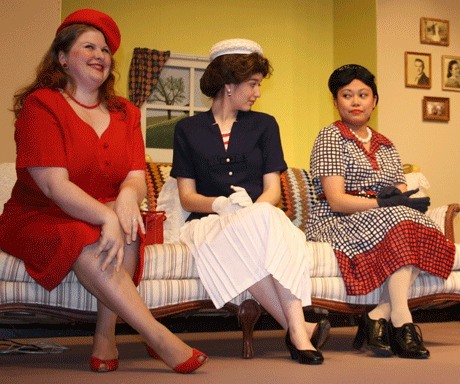A feel-good photo that graced the cover of Life magazine in the 1940s turns out to have a dark underside in “The Cover of Life” opening Friday, Feb. 5 at the Whidbey Playhouse.
Kate Miller (Cynthia Kleppang) is our narrator, a Lois Lane-type character and Life correspondent who is thrust into southern women territory.
She’s reporting a “woman’s piece” about three wives who have come to live with their mother-in-law, who goes by Aunt Ola, while the boys are at war.
Apart from a few squabbles, it’s a pretty civil household, until the second half. That’s when the wives’ happy facade breaks down, and bad news and wartime separation takes its toll on the women.
“The newlyweds don’t know what marriage is all about because their husbands quickly moved away,” said director Rusty Hendrix. “It’s a touching story.”
The play is set in a tiny, Louisiana town, and we see Aunt Ola’s early Americana-style home, porch and screen door. The sets were built by Bob Hendrix, Rusty’s husband.
After some insistence, Kate moves in with the wives. She meets the modern and racy Sybil (Amanda McCartney), who describes herself as “hot as a Saturday night and safe as Sunday morning.”
Weetsie (Michelle Hunter) maintains that she’s a plain, common housewife, while Tood (Lisa Datin) just wants to break free of the family and start a life elsewhere.
Mary K. Hallen is the homespun Aunt Ola who has a feisty sense of humor. When the newlyweds spar, Hallen nicely conveys strength as the family matriarch.
Although the script is considered a bit dark, Hendrix said her cast brought some playfulness to the characters.
“What they made is better,” she said.
Rounding out the cast are Judy Hendrix as Addie Mae, the gossipy local reporter who tipped off Life in the first place, and Fernando Duran, who plays Tood’s husband.
“The Cover of Life” is a show (like it’s punning title) that hints that life isn’t always what appears on the outside. It also briefly casts a light on a media that won’t let personal feelings ruin the story it wants.
Part social commentary, humor, drama and hope, it’s a surprising and deep story written by R.T. Robinson. Hendrix said it may touch on some feelings of Oak Harbor’s military families. She adds that a few of the play’s scenes are “too strong” at times, and it is not for children.


